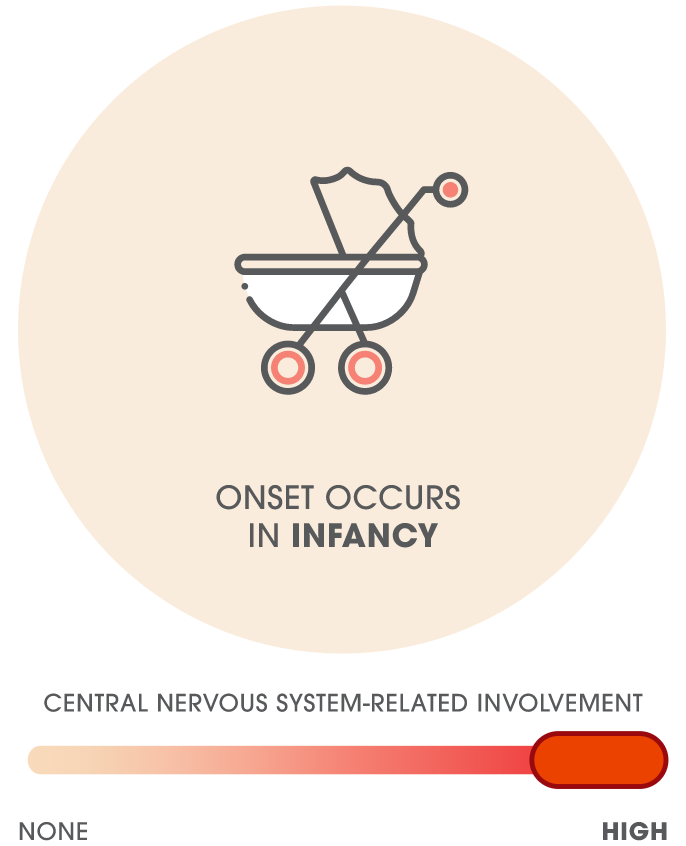Spectrum of Gaucher disease symptoms
TYPE 1
NON-NEURONOPATHIC FORM

You may experience no symptoms (asymptomatic), a combination of symptoms, or all the symptoms. Even if you do not notice symptoms, you may still have effects of Gaucher disease type 1 (GD1).
ORGANS
- Enlarged spleen (splenomegaly) and/or enlarged liver (hepatomegaly) that can make you feel bloated or have a bulging belly (abdomen)
- Scarring (fibrosis) of the liver
BLOOD
- Fewer healthy red blood cells (anemia) that may lead to fatigue
- Low blood platelet count (thrombocytopenia) that makes it harder for your blood to clot. This may result in easy bruising or bleeding.
BONES
- Loss of bone minerals (osteopenia and osteoporosis) that can weaken the bones and may increase the risk for a bone to break
- Delayed growth in children
- Joint pain, arthritis, joint deformity, and joint damage
- Severe pain caused by lower blood flow to bones (bone pain and bone crisis)
- Bone erosion and the collapse of the bone itself may occur (bone infarction or avascular necrosis [AVN])
94% of patients with type 1 have signs of bone disease. Your bones may be affected even if you are not feeling bone pain.
TYPE 3
CHRONIC NEURONOPATHIC FORM

Gaucher disease type 3 (GD3) typically presents in childhood. Some patients may have symptoms as an infant or young toddler, while others may not experience symptoms until pre-teen years. Symptoms usually get worse (progress) over time, but the rate of progression and onset of additional symptoms may vary.
All patients with GD3 have difficulty moving the eyes (gaze palsy), but because of disease variability, may not discover this symptom until later in life.
CENTRAL NERVOUS SYSTEM, VARIABLE ONSET
- Eye movement disorders, including gaze palsy
- Tremors, muscle weakness, muscle stiffness, slow movement, imbalance, and incoordination (also known as Parkinsonian manifestations)
- Seizures causing you to fall, shake, or become unaware of your surroundings
OTHER FEATURES SUGGESTIVE OF GD3
- Excessive curving of the spine (kyphosis)
- Lung disease
- Swelling in the lower limbs
- Non-cancerous tumors (Gaucheromas)
- Heart valve problems (cardiac calcification)
ALSO INCLUDES ORGAN, BLOOD, AND BONE SYMPTOMS SEEN IN TYPE 1
TYPE 2
ACUTE INFANTILE NEURONOPATHIC FORM

Gaucher disease type 2 (GD2) symptoms have a much earlier, faster onset than the other types. Patients with GD2 have onset of central nervous system symptoms by 6 months of age and rapid nervous system decline in the first 2 years of life.
CENTRAL NERVOUS SYSTEM, EARLY ONSET
- Noisy and difficult breathing that occurs due to partially blocked air flow through a narrowed airway
- Will not learn to walk independently
- Developmental delay and worsening cognitive decline
- Poor weight gain
- Trouble opening the mouth and difficulty swallowing or speaking
- Stiff or rigid muscles and overactive reflex response
- Gaze palsy
ALSO INCLUDES ORGAN AND BLOOD SYMPTOMS SEEN IN TYPE 1

Some patients with Gaucher disease type 1 may not notice symptoms. These patients may still have effects of the disease such as fewer blood cells, enlarged spleen, or certain bone diseases.
Testing for Gaucher disease is the only way to confirm a diagnosis.
Sanofi is committed to the rare disease community.
.png)